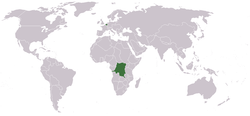International Association of the Congo
Coordinates: 2°52′48″S 23°39′22″E / 2.88°S 23.656°E
| International Congo Society Association internationale du Congo | |||||||||||
|---|---|---|---|---|---|---|---|---|---|---|---|
| 1879–1885 | |||||||||||
 | |||||||||||
 | |||||||||||
| Status | Provisional government | ||||||||||
| Capital | Boma | ||||||||||
| Owner | |||||||||||
| Chairman | |||||||||||
| Plenipotentiary | |||||||||||
| Historical era | New Imperialism | ||||||||||
• Established | 17 November 1879 | ||||||||||
• Flag recognised | 10 April 1884 | ||||||||||
• Sovereignty recognised | 8 November 1884 | ||||||||||
• Free state established | 1 July 1885 | ||||||||||
| ISO 3166 code | CG | ||||||||||
| |||||||||||
The International Association of the Congo (French: Association internationale du Congo), also known as the International Congo Society, was an association founded on 17 November 1879 by Leopold II of Belgium to further his interests in the Congo.[1] It replaced the Belgian Comité d'Études du Haut-Congo ("Committee for the Study of the Upper Congo"),[2] which was part of the International African Association front organisation created for the exploration of the Congo. The goals of the International Congo Society was to establish control of the Congo Basin and to exploit its economic resources.[3] The Berlin Conference recognised the society as sovereign over the territories it controlled and in 1885 its structures were acquired by the Congo Free State.[4]
Ownership and control
The official stockholders of the Committee for the Study of the Upper Congo were Dutch and British businessmen and a Belgian banker who was holding shares on behalf of Leopold. Colonel Maximilien Strauch, president of the committee, was a henchman of Leopold. It was not made clear to Henry Morton Stanley, who signed a five-year contract to establish bases in the Congo in 1878, whether he was working for the International African Association, the Committee for Study of the Upper Congo, or Leopold himself. Stanley's European employee contracts forbade disclosure of the true nature of their work.[5]
Berlin Conference
The Berlin Conference or Congo Conference of 1884–85 regulated European colonisation and trade in Africa. King Leopold II was able to convince the powers at the conference that common trade in Africa was in the best interests of all countries.[6] The General Act of the conference divided Africa between the main powers of Europe[7] and confirmed the territory controlled by the Congo Society as its private property, which essentially made it the property of Leopold II.[8]
On 10 April 1884 the United States Senate authorised President Chester A. Arthur "to recognize the flag of the AIC as the equal of that of an allied government".[9] On 8 November 1884 Germany recognised the sovereignty of the society over the Congo.[10]
See also
- Corporatocracy
- Brussels Anti-Slavery Conference 1889–90
- Brussels Conference Act of 1890
- Royal Museum for Central Africa
- List of boats used for exploration of the Congo
External links
- Timeline for Congo — History Commons
References
- ↑ "Association Internationale du Congo". Encyclopædia Britannica. 22 March 2007.
- ↑ Memo from Belgium. 1978. p. 210.
- ↑ Rorison, Sean (2012-07-20). Congo: Democratic Republic - Republic. Bradt Travel Guides. p. 63. ISBN 9781841623917.
- ↑ Simmonds, R. (2012-12-06). Legal problems arising from the United Nations military operations in the Congo. Springer. p. 26. ISBN 9789401192675.
- ↑ Hochschild, Adam (2011-05-13). King Leopold's Ghost: A Story of Greed, Terror and Heroism in Colonial Africa. Pan Macmillan. p. 81. ISBN 9780330469944.
- ↑ V, Dom Pedro (2011-12-22). The Quantum Vision of Simon Kimbangu: Kintuadi in 3D. Xlibris Corporation. p. 128. ISBN 9781469140360.
- ↑ Ndahinda, Felix Mukwiza (2011-04-27). Indigenousness in Africa: A Contested Legal Framework for Empowerment of 'Marginalized' Communities. Springer Science & Business Media. p. 304. ISBN 9789067046091.
- ↑ Pinder, Kymberly N. (2002). Race-ing Art History: Critical Readings in Race and Art History. Psychology Press. p. 237. ISBN 9780415927604.
- ↑ Förster, Stig; Mommsen, Wolfgang Justin; Robinson, Ronald Edward (1988). Bismarck, Europe and Africa: The Berlin Africa Conference 1884-1885 and the Onset of Partition. Oxford University Press [for] German Historical Institute. p. 240. ISBN 9780199205004.
- ↑ Nzongola-Ntalaja, Georges (2013-07-18). The Congo from Leopold to Kabila: A People's History. Zed Books Ltd. p. 29. ISBN 9781780329406.